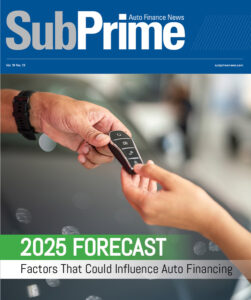GMAC Shows 3Q Strength in Auto Financing Business
NEW YORK — Boosted by originations returning to more normal levels, credit improvements and used-car prices, GMAC reported this week that it global auto finance business had a third-quarter pre-tax income from continuing operations of $395 million, compared to a pre-tax loss from continuing operations of $379 million a year ago.
"Continuing operations in the segment were driven by the continued normalization of origination volumes, credit improvement and used-vehicle prices," officials noted, also pointing out that these results exclude certain discontinued operations, which are composed of auto finance operations in Argentina and full-service leasing operations in the U.K. and Italy.
Consumer financing originations during the period totaled $7.7 billion, compared with $13.3 billion a year ago.
New originations were $6.8 billion, down from $9.2 billion a year ago. Used originations reached roughly $800 million, versus $2 billion in the third quarter of 2008. Meanwhile, new-lease originations totaled approximately $100 million, compared with $2.1 billion in new lease/retail balloon contracts a year ago.
"Originations were lower compared to the prior year primarily due to a decrease in U.S. vehicle sales and lower leasing levels," executives noted. "Consumer financing origination levels continued to trend upward on a sequential basis as originations were up 26 percent from $6.1 billion in the second quarter of 2009."
They added: "The increase from last quarter includes improved pricing competitiveness, an increase in Chrysler originations and the effect of the Cash for Clunkers program."
Continuing on, GMAC said it continues to make strides regarding its financing for Chrysler dealers and customers.
In fact, roughly $720 million of Chrysler retail loans were originated during the third quarter, up approximately $520 million from the second quarter.
Also, GMAC's penetration of U.S. retail sales for Chrysler was 21 percent in September, versus 10 percent in June.
As of Sept. 30, GMAC said its outstanding balance for wholesale financing of Chrysler dealers was $3.3 billion. Officials noted that Chrysler wholesale penetration in the U.S. was 67 percent, and it was 85 percent in Canada, as of the quarter's end.
Moving on, quarterly credit losses were 3.29 percent of managed retail assets, compared with 1.56 percent a year ago.
"The increase is primarily due to a standardization of the company's charge-off policy to conform to regulatory requirements, the effect of a smaller asset base and the underlying performance of certain subprime portfolios," officials stated.
"Lower loss severities in North America have partially offset weak economic trends. Excluding the effect of the change in the charge-off policy, credit losses would have been 2.19 percent of managed retail assets in the third quarter of 2009," they added.
Delinquencies jumped to 3.76 percent in the period, up from 2.77 percent last year and 3.48 percent in the second quarter.
"Delinquency trends have been negatively affected by higher unemployment and a smaller asset portfolio in North America and Europe," executives shared.
GMAC Financial Services
As a whole, GMAC Financial Services' third-quarter performance was downwardly impacted by losses related to the legacy assets in the mortgage operations. However, officials said the company is making progress toward its transformation.
Overall, the company reported a net loss of $767 million, much lower than the $2.5 billion loss it recorded a year ago.
Explaining the quarterly results, officials noted that certain business lines of GMAC were noted as discontinued operations during the period.
These include GMAC's U.S. consumer property and casualty insurance business as well as three international auto financing businesses.
All of these businesses have been taken out of the company's continuing operations.
So, when their results are excluded, the quarterly net loss is $671 million, versus $2.5 billion in the third quarter of 2008.
According to officials, GMAC's continuing operations were impacted by the following during the period, which include the following:
—$515 million mortgage repurchase reserve expense.
—$161 million loss provision on resort finance assets.
—$309 million original issue discount amortization expense related to the December 2008 bond exchange.
—$79 million legacy mortgage provision expense.
—$292 million tax benefit on operating losses.
—$155 million mark-to-market gain on auto retained interests.
—$23 million net recovery on commercial and international portfolio marks/write-downs.
When these items are excluded, the company's net loss from continuing operations falls to $77 million.
"We continue to work through solutions for certain legacy assets, and that is still weighing on GMAC's financial performance," explained Alvaro de Molina, chief executive officer of GMAC. "Progress is being made toward the transformation of the company as we shed non-strategic operations while at the same time invest in structuring the company to be more competitive for the long term."
He added: "Our focus is on growing operations where we can leverage our strengths. We have made major strides in bringing the Chrysler business on line, we launched a competitive dealer program that leverages our full suite of auto products, and Ally Bank continues to attract customers."
Regarding liquidity, GMAC's consolidated cash and cash equivalents were $14.2 billion at the end of the quarter, compared with $18.7 billion as of June 30.
Breaking down the consolidated cash and cash equivalents balance, it includes:
—$919 million at Residential Capital, LLC (ResCap).
—$5 billion at Ally Bank, which excludes $5.2 billion of intercompany overnight funds on deposit at Ally Bank.
—$75 million at the insurance business.
"The decrease in consolidated cash reflects investment into high quality debt securities and the repayment of unsecured debt maturities," officials explained.
The company's total equity was $24.9 billion, off $1.1 billion from the end of the previous quarter. Executives attributed this marginal decrease to net loss in the quarter and payment of preferred dividends.

 View The Latest Edition
View The Latest Edition

